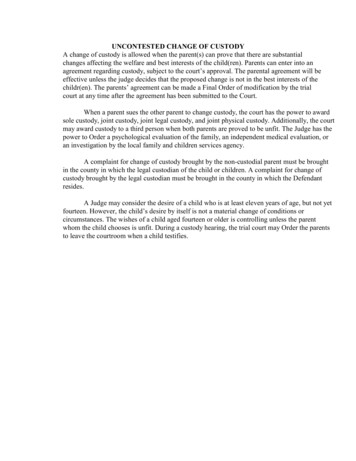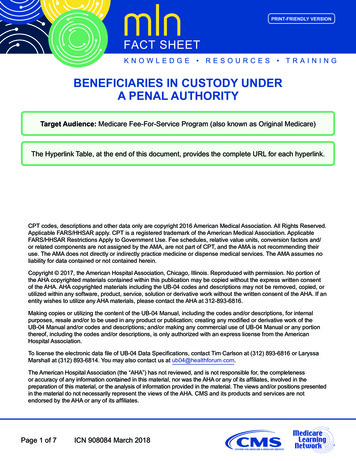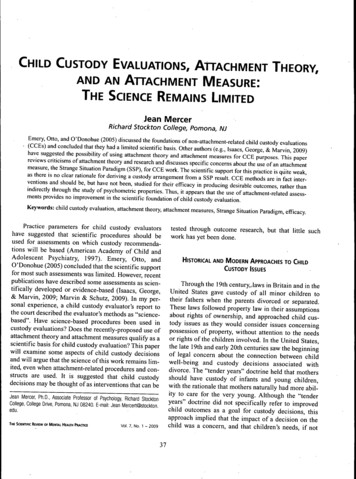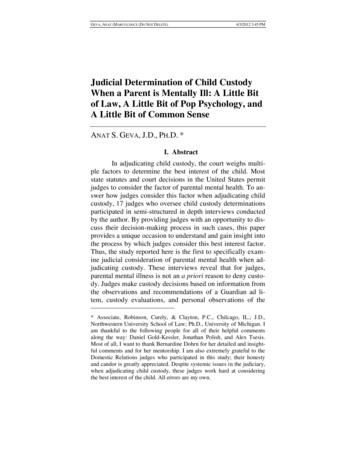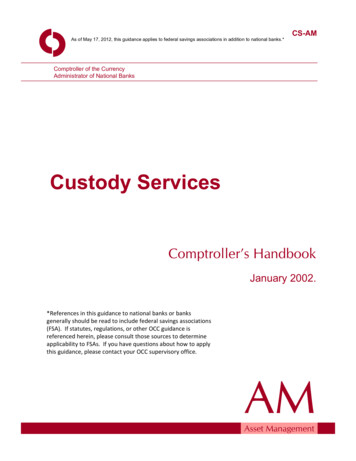
Transcription
As of May 17, 2012, this guidance applies to federal savings associations in addition to national banks.*CS-AMComptroller of the CurrencyAdministrator of National BanksCustody ServicesComptroller’s HandbookJanuary 2002.*References in this guidance to national banks or banksgenerally should be read to include federal savings associations(FSA). If statutes, regulations, or other OCC guidance isreferenced herein, please consult those sources to determineapplicability to FSAs. If you have questions about how to applythis guidance, please contact your OCC supervisory office.AMAsset Management
As of May 17, 2012, this guidance applies to federal savings associations in addition to national banks.*Custody ServicesTable of ContentsOVERVIEW . 1Background . 1The Custody Services Industry . 1Services Provided by a Custodian . 1Risks Associated with Custody Services . 2Transaction Risk . 3Compliance Risk . 3Credit Risk. 4Strategic Risk . 5Reputation Risk . 5Risk Management . 6Operational Controls . 6Account Acceptance and Monitoring. 7Management Information Systems . 8Board and Management Supervision. 9Staffing . 9Compliance. 9Global Sub-Custodian Network . 13Due Diligence - Markets . 13Due Diligence - Sub-Custodian banks. 13Safekeeping and Settlement . 14Safekeeping of Custody Assets . 15Settlement of Securities Transactions . 17Reporting and Recordkeeping. 21Cash Management . 22Foreign Exchange . 22Securities Servicing. 23Income Collection . 23Corporate Actions. 24Tax Reclaims . 25Securities Lending . 26The Evolution of Securities Lending Markets . 27The Role of Bank Custodians . 27The Securities Lending Transaction. 28Due Diligence Considerations . 29Law and Taxation Matters . 32Comptroller’s HandbookiCustody Services
As of May 17, 2012, this guidance applies to federal savings associations in addition to national banks.*Collateral Management. 33Securities Lending Operations . 35International Securities Lending . 36Other Value-Added Services . 36Risk Measurement and Management . 37Compliance Monitoring. 37Performance Measurement . 37Banks as Users of Custody Services. 37Document Custody Services . 38EXAMINATION PROCEDURESGeneral Procedures .41Quantity of Risk.43Quality of Risk Management.47Conclusions .65APPENDICESA.Glossary .69B.Corporate Actions.87C.Investment Company Act of 1940 Custody Rules.91D.New York Stock Exchange Rule 387 .98REFERENCES .103Custody ServicesiiComptroller’s Handbook
As of May 17, 2012, this guidance applies to federal savings associations in addition to national banks.*Custody ServicesOverviewBackgroundThis booklet addresses the fundamentals of securities custody and relatedservices, and provides guidance for examining those activities in nationalbanks. One of a series of specialized asset management booklets in theComptroller’s Handbook, the booklet supplements the overall guidance inthe “Asset Management Supervision” booklet as well as the “Large BankSupervision” and “Community Bank Fiduciary Activities” booklets. Foradditional guidance on general asset management operations and controls,please refer to the Comptroller’s Handbook for Asset Management. Pleaserefer to this booklet’s glossary for definitions of terms used in this handbook.The Custody Services IndustryThe ability to gather assets, effectively employ technology, and efficientlyprocess huge volumes of transactions is essential in the custody businesstoday. With the growth of the investment industry during the past twodecades, particularly in the mutual fund arena, the level of assets undercustody has increased significantly. Competition for custody of those assetshas been fierce, causing profit margins to shrink. At the same time, theindustry has focused on using technology to improve efficiency. As a result, ahandful of large banks now dominate the custody services industry.Services Provided by a CustodianServices provided by a bank custodian are typically the settlement,safekeeping, and reporting of customers’ marketable securities and cash. Acustody relationship is contractual, and services performed for a customermay vary. Banks provide custody services to a variety of customers,including mutual funds and investment managers, retirement plans, bankfiduciary and agency accounts, bank marketable securities accounts,insurance companies, corporations, endowments and foundations, andprivate banking clients. Banks that are not major custodians may providecustody services for their customers through an arrangement with a largecustodian bank.Comptroller’s Handbook1Custody Services
As of May 17, 2012, this guidance applies to federal savings associations in addition to national banks.*Core Custody ServicesA custodian providing core domestic custody services typically settles trades,invests cash balances as directed, collects income, processes corporateactions, prices securities positions, and provides recordkeeping and reportingservices.Global Custody ServicesA global custodian provides custody services for cross-border securitiestransactions. In addition to providing core custody services in a number offoreign markets, a global custodian typically provides services such asexecuting foreign exchange transactions and processing tax reclaims. Aglobal custodian typically has a sub-custodian, or agent bank, in each localmarket to help provide custody services in the foreign country. The volumeof global assets under custody has grown rapidly in recent years as investorshave looked to foreign countries for additional investment opportunities.Securities Lending and Other Value-Added ServicesA bank may offer securities lending to its custody customers. Securitieslending can allow a customer to make additional income on its custody assetsby loaning its securities to approved borrowers on a short-term basis. Inaddition, a custodian may contract to provide its customers with other valueadded services such as performance measurement, risk measurement, andcompliance monitoring.Risks Associated with Custody ServicesFor purposes of the OCC’s discussion of risk, the OCC assesses banking riskrelative to its impact on capital and earnings. From a supervisory perspective,risk is the potential that events, expected or unexpected, may have an adverseimpact on a bank’s capital or earnings. The OCC has defined nine categoriesof risk for bank supervision purposes: credit, interest rate, liquidity, price,foreign currency translation, transaction, compliance, strategic, andreputation. These categories are not mutually exclusive; any product orservice may expose a bank to multiple risks. For analysis and discussion,however, the OCC identifies and assesses the risks separately. The primaryrisks associated with custody services are: transaction, compliance, credit,strategic, and reputation. These risks are discussed more fully in thefollowing paragraphs.Custody Services2Comptroller’s Handbook
As of May 17, 2012, this guidance applies to federal savings associations in addition to national banks.*Transaction RiskTransaction risk is the current and prospective risk to earnings or capital fromfraud, error, and the inability to deliver products or services, maintain acompetitive position, and manage information. Risk is inherent in efforts togain strategic advantage, and in the failure to keep pace with changes in thefinancial services marketplace. Transaction risk is evident in each productand service offered. Transaction risk encompasses product development anddelivery, transaction processing, systems development, computing systems,the complexity of products and services, and the internal controlenvironment.Transaction risk is also referred to as operational risk. This risk is inherentlyhigh in custody services because of the high volume of transactions processeddaily. Experience in the custody field has shown that errors in corporateaction, settlement, foreign exchange (FX), and operating (suspense) accountprocessing are common causes of losses attributable to custody activities.These losses, individually and in the aggregate, may be material. Effectiverisk identification and control can greatly mitigate these errors.Effective policies and procedures, a strong control environment, and efficientuse of technology are essential risk management tools. Meaningful reporting,based on accurate and reliable data, is needed to provide management withmonitoring tools. The risks may be magnified in a global custody operationwhere transactions occur around the clock in a variety of different markets. Aglobal custodian must consider a variety of additional factors includingdiffering market rules and conventions, the degree of automation in theforeign market, different types of securities, capital or currency restrictions,and the availability and communication of timely and accurate information.Compliance RiskCompliance risk is the current and prospective risk to earnings or capitalarising from violations of, or nonconformance with, laws, rules, regulations,prescribed practices, internal policies and procedures, or ethical standards.Compliance risk also arises in situations where the laws or rules governingcertain bank products or activities of a bank’s clients may be ambiguous oruntested. Compliance risk exposes the institution to fines, civil moneypenalties, payment of damages, and the voiding of contracts. Compliancerisk can also lead to a diminished reputation, reduced franchise value, limitedComptroller’s Handbook3Custody Services
As of May 17, 2012, this guidance applies to federal savings associations in addition to national banks.*business opportunities, reduced expansion potential, and an inability toenforce contracts.Custody services are contractual in nature, and a bank must ensurecompliance with the provisions of all applicable agreements. A strongcompliance program should include monitoring the variety of laws andregulations that may affect a custodian’s business and reporting any materialchanges to the customer. Global custodians in particular must be aware ofthe regulatory environments in which they operate. Compliance risk may beheightened in foreign markets because different markets have different rulesand regulations. These differences make supervision challenging.Credit RiskCredit risk is the current and prospective risk to earnings or capital arisingfrom an obligor’s failure to meet the terms of any contract with the bank orotherwise to perform as agreed. Credit risk is found in all activities thatdepend on counterparty, issuer, or borrower performance. It arises any timefunds are extended, committed, invested, or otherwise exposed throughactual or implied contractual agreements, whether reflected on or off thebalance sheet.The U.S. market settlement practice of delivery versus payment (DVP)virtually eliminates counterparty credit risk in the settlement process.However, a custodian may be exposed to credit risk if it advances funds tosettle trades for a customer. In addition, securities lending activities mayexpose a bank to counterparty credit risk. For further information on creditrisk please refer to the Comptroller’s Handbook.Global custodians may be exposed to credit risk from several sources. First, ifa sub-custodian fails, the custodian may have difficulty obtaining itscustomers’ securities. Second, not all markets settle transactions DVP, sothere is risk if the custodian delivers securities without receiving payment orpays without receiving securities. Third, in some markets a custodian mayoffer contractual settlement. In this case, a custodian makes the entries to itscustomer’s account on the contractual settlement date even if the custodianhasn’t actually received the cash or securities needed to settle the trade.Here, the credit risk is with the global custodian’s customer. Contractprovisions should provide for reversal of the transaction if the trade fails or aspecified amount of time passes.Custody Services4Comptroller’s Handbook
As of May 17, 2012, this guidance applies to federal savings associations in addition to national banks.*Strategic RiskStrategic risk is the current and prospective risk to earnings or capital arisingfrom adverse business decisions, improper implementation of decisions, orlack of responsiveness to industry changes. This risk depends on thecompatibility of an organization’s strategic goals, the business strategiesdeveloped to achieve those goals, the resources deployed toward these goals,and the quality of implementation. The resources needed to carry outbusiness strategies are both tangible and intangible. They includecommunication channels, operating systems, delivery networks, andmanagerial capacities and capabilities. The organization’s internalcharacteristics must be evaluated against the impact of economic,technological, competitive, regulatory, and other environmental changes.A bank’s decision to participate in the custody business, and its ability to becompetitive if it does, is a source of strategic risk to the bank. The industryhas seen increased competition in recent years, which has reduced marginsand forced industry consolidation. To compete, a custodian must be able toachieve a size that creates an economy of scale, and continually invest insystems and technology.Reputation RiskReputation risk is the current and prospective impact on earnings and capitalarising from negative public opinion. This affects the institution’s ability toestablish new relationships or services or to continue servicing existingrelationships. This risk may expose the institution to litigation, financial loss,or a decline in its customer base. Reputation risk exposure is presentthroughout the organization and includes the responsibility to exercise anabundance of caution in dealing with its customers and community.The importance of a custodian’s reputation cannot be overstated. The abilityof the bank to deliver services as promised is critical to maintaining itsreputation. The transaction-oriented custody services business makes abank’s failure to perform a contracted service highly visible to its customer.Virtually any problem that the bank encounters in its custody business linecan affect its reputation if it is made public.A bank’s custody customers may also be exposed to interest rate, liquidity,price, credit, and foreign currency translation risk through the assets they holdComptroller’s Handbook5Custody Services
As of May 17, 2012, this guidance applies to federal savings associations in addition to national banks.*in their custody accounts. Although any related losses are not direct risks tothe bank providing custody services, some customers may hold the bank atfault for them. The possibility that these customers will make their claims orallegations public presents some reputation risk.Risk ManagementExaminers should determine whether a bank has adequate systems in place toidentify, measure, monitor, and control risks in the custody services area.Such systems include policies, procedures, internal controls, andmanagement information systems governing custody services.Effective internal control is essential to a bank’s management of the risksfound in custody services. A properly designed and consistently enforcedsystem of internal controls will help management safeguard assets undercustody, produce reliable financial reports, and comply with laws andregulations. For additional discussion of the internal control environment,refer to the “Internal Control” booklet of the Comptroller’s Handbook.Operational ControlsThe importance of operational controls in the custody services area cannot beoveremphasized. Custody is a volume-driven, transaction-processingbusiness, and much of the risk associated with it is operational in nature. Forthis reason, strong operational controls are essential to effectively managetransaction risk.Separation of DutiesControl can best be achieved through a division of duties. A bank firstsegregates administrative and operational functions, and then it segregatesduties (both physical and logical access) within the operating system itself. Itis the responsibility of management to assess the control environment andensure that an appropriate system of internal control, including separation ofduties, is in place.Dual ControlAssets under custody should be properly controlled and safeguarded at alltimes. Dual control procedures should ensure that one person, acting alone,does not have the ability to complete all phases of a transaction, or movecustody assets. Procedures should require dual control in processing of allCustody Services6Comptroller’s Handbook
As of May 17, 2012, this guidance applies to federal savings associations in addition to national banks.*custody assets, including securities, cash, income payments, and corporateactions.Accounting ControlsIndependent control processes should ensure the accuracy of a custodian’srecords and accounting systems. Accounting controls are used to monitorand measure transactional work flows and their accuracy. Accountingcontrols include blotters, reconcilement of cash and asset movements, andsuspense accounts.Account Acceptance and MonitoringThe account acceptance process is the first step in risk management. Therisks associated with an individual account should be addressed prior toacceptance. A custodian’s acceptance process should provide an adequatereview of the customer’s needs and wants. During the acceptance process,the custodian should also assess whether its duties are within its capabilities,are lawful, and can be performed profitably.ProceduresA properly documented account acceptance process will provide sufficientinformation for the bank to make an informed decision. Risk-basedprocedures should provide sales personnel with "front-end guidance" relatedto the review and acceptance of new accounts, and should include a bank’srequirements related to customer due diligence and required documentation.Assessment of New BusinessThe due diligence process should ensure that the services the customer wantsthe custodian to perform are legal (in the relevant jurisdictions) and within thecustodian’s capabilities. The account acceptance process should include anassessment of the proposed relationship including a review of the productsand services needed by the customer, likely transactions (type and volume),and customer information necessary to facilitate custody transactions (such astax information related to foreign tax relief). The due diligence processshould include a review for compliance with anti-money laundering rules.Please refer to the “Bank Secrecy Act/Anti-Money Laundering” booklet of theComptroller’s Handbook for further information.When accepting new business the bank should consider the operationalneeds of the account. The bank should consult all applicable departmentsComptroller’s Handbook7Custody Services
As of May 17, 2012, this guidance applies to federal savings associations in addition to national banks.*(including legal, accounting, operations, credit, and compliance) to determinewhether it has the capacity to serve the customer without incurringunreasonable costs.AgreementsCustody relationships are contractual in nature and are essentially directedagencies. The customer is the principal, and the custodian is the agent. Thecustody agreement is important as a risk management tool. The agreementshould clearly establish the custodian’s duties and responsibilities. Custodyagreements should be standardized when possible, and any deviations fromthe standardized agreement should be reviewed prior to acceptance.Management Information SystemsA management information system (MIS) is a system or process that providesthe information necessary to manage an organization effectively. MIS and theinformation it generates are generally considered essential to internal control.A primary objective of custody services MIS is the management of transactionrisk. Sound MIS produces information that is accurate, timely, consistent,complete, and relevant. It allows a bank to measure operational performanceto designated benchmarks. While a custodian’s MIS enables a bank todetermine whether its operations are profitable, it should also informmanagement about other essential matters, such as whether internal controlsare working. Refer to the “Management Information System” booklet of theComptroller’s Handbook for additional information.Contingency PlanA contingency plan is an extension of a bank’s system of internal control andphysical security. The plans should include provisions for continuance ofoperation, and recovery when threats may damage or disrupt the institution’sdata processing support. A bank that relies on an outside servicer for the bulkof its data processing should take steps to determine whether the contingencyplans of the servicer are adequate and whether its own plans complementthose of the servicer.Comprehensive contingency planning policies and procedures for allbusiness lines are a responsibility of the board of directors and seniormanagement of a national bank. The board is responsible for reviewing andapproving the institution’s contingency plans annually and documenting thereviews in its minutes.Custody Services8Comptroller’s Handbook
As of May 17, 2012, this guidance applies to federal savings associations in addition to national banks.*Board and Management SupervisionNational bank directors are expected to perform general supervision over abank’s activities. Directors may assign the administration of custody activitiesto such officers, directors, employees, or committees as they may designate.However, directors retain the overall responsibility for supervision. Anyworkable system or organization of a custody operation may be acceptable aslong as the directors are fully aware of and are fulfilling their responsibilities.StaffingCapable management and appropriate staffing are essential to effective riskmanagement. Experienced staff, adequate training, and the ability to manageturnover play a major role in a bank’s ability to offer high quality andconsistent performance in custody services. A bank must carefully compareits custody staffing levels with the volume of business and the complexity ofthe services offered. If staffing is not adequate to handle the volume ofbusiness, transactions may be poorly executed, customer service may beinadequate, and the bank may lose both dollars and customers.ComplianceThe board and management are responsible for ensuring that a bank’scustody activities comply with applicable laws and regulations. All applicablelaws and regulations relevant to the custody business should be identifiedand communicated to the appropriate personnel. The custodian should havea system in place to monitor for compliance with applicable laws andregulations.Some of the compliance issues that may arise for custodians are compliancewith local law, recordkeeping and confirmation requirements, shareholdercommunication, mutual fund custody, retirement plan assets, fiduciaryactivities, anti-money laundering, securities lending, and free-riding.Local LawCustodians, particularly global custodians, may be affected by a variety oflaws and regulations. In addition to U.S. federal laws and regulations, thecustodian may be subject to state laws, and laws of foreign countries in whichthey offer services. In foreign countries, the global custodian will typicallyComptroller’s Handbook9Custody Services
As of May 17, 2012, this guidance applies to federal savings associations in addition to national banks.*rely on its sub-custodian to understand and comply with local laws andregulations. Local laws may address such issues as:·····Fiduciary capacity. A custodian may be considered to be a fiduciaryunder law in some jurisdictions.Unclaimed property. Most states have an unclaimed property law. Theseprovisions may require a custodian to escheat unclaimed property to thestate. ERISA preempts state unclaimed property laws for retirement planassets. Globally, unclaimed property laws vary widely.Taxation. Countries’ tax policies on investment income and capital gainsdiffer. The United States may have tax treaties with other countries thatprovide tax relief.Money laundering or suspicious activity. To prevent money launderingand other illegal activities, a wide range of laws and regulations exist thatmay require banks to identify customers and report suspicious activities.Reporting and recordkeeping. A custodian may be subject to regulatoryreporting and recordkeeping requirements in the countries in which itoffers services.Global custodians operate in multiple regulatory environments. They musthave an effective process in place to identify regulatory and market changesand ensure continued compliance.Securities Transactions12 CFR 12 establishes minimum recordkeeping and confirmationrequirements for securities transactions handled by national banks. Theregulation also requires that banks establish policies and procedures coveringsupervision of securities transactions and reporting of personal transactions.Shareholder CommunicationsThe Shareholder Communications Act and implementing SEC regulationsaddress banks’ proxy processing. The objective of these rules is to ensurethat beneficial owners of securities are provided proxy material and othercorporate communications in a timely manner.Mutual FundsThe Investment Company Act of 1940 and 17 CFR 240.17f address thecustody of investment company (mutual fund) assets. In 2000, the SECrevised rule 17f-5, which addresses custody of fund assets outside the UnitedStates, and added a rule 17f-7 to address custody of fund assets with foreignCustody Services10Comptroller’s Handbook
As of May 17, 2012, this guidance applies to federal savings associations in addition to national banks.*securities depositories. For the complete text of the final rule, refer toappendix C.Retirement Plan AssetsA bank providing custody for retirement plan assets may have additionalduties under the Employee Retirement Income Security Act (ERISA). Whatfollows are examples of ERISA’s implications in the custody services area:···The Department of Labor (DOL) approved a class exemption relating toforeign exchange transact
Services Provided by a Custodian . Services provided by a bank custodian are typically the settlement, safekeeping, and reporting of customers' marketable securities and cash. A custody relationship is contractual, and services performed for a customer may vary. Banks provide custody services to a variety of customers,



